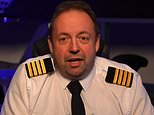
A pilot has debunked the some of the most common flying fears, from the plane having to emergency land on water to what happens when there’s a fire onboard.
Mark works as an Airbus captain for a commercial airline and set about calming down nervous passengers by explaining what exactly happens on an aircraft.
When flying thousands of feet in the air, the last thing any holidaymaker wants to deal with is a fire.
Fortunately, Mark revealed in a video on Airliners Live YouTube channel how there are plenty of protocols in place.
‘The first thing we do is we identify where the fire is, if it’s in the engines we get an alert in the cockpit, we have fire extinguishers in the engines we put the fire out,’ he explained.
Whereas, a fire in the tail of the plane would be dealt with via a fire extinguisher.
‘The most likely cause we see on flights, we get the smoke alarm in the toilets going off, someone’s gone in there, had a vape, had a cigarette set the smoke alarm off,’ Mark said.
‘We get a load of alarms going off in the flight deck, the cabin crew get a load of alarms and they go in very very quickly and we have procedures, we have fire extinguishers on board to put it out.
Mark works as an airbus captain for a commercial airline and set about calming down nervous passengers by explaining what exactly happens on an aircraft
‘Even the toilet bins have built in fire extinguishers. We identify where the fire is coming from and we put it out.’
Recently, more airlines have began banning passengers from bringing power banks on board.
Mark explained there are new procedures for lithium battery fires, caused by power banks, phones and laptops.
‘If we have one of those fires, then we divert the aircraft to get the offending battery off the aircraft,’ he revealed.
Mark shared that the cabin crew follow special procedures, too, and use things like ‘smoke hooks’ that supply oxygen and ‘fire proof gloves’ as well as fire extinguishers.
‘Our cabin crew are incredibly highly trained to deal with these fires and they regularly go through training sessions to deal with these on-board fires,’ he said.
As for water landings, which are typically used in emergency situations, Mark explained how pilots will ‘extinguish every single option’ before choosing to land on water.
‘I’ve got to say, it’s incredibly rare it happens but as we saw on the Hudson, it is possible and it is completely survivable, every single person walked away,’ he said.
When flying thousands of feet in the air, the last thing any holidaymaker wants to deal with is a fire
In 2009, Captain Chesley ‘Sully’ Sullenberger safely performed an emergency landing in the Hudson River, New York and all 155 people on board the flight survived.
Another concern some passengers might have is what happens if the pilot becomes ill.
Mark was quick to dispel any worries and said: ‘There’s always at least two of us in the flight deck, if one of the guys becomes ill then we’ll get the cabin crew in, we’ll give them some oxygen if need be, assess the situation.
‘They may recover fine, they may be able to continue with the flight or they may become what we call incapacitated.’
The pilot explained how ‘it’s not a big deal’ if one of the pilots can no longer fly.
‘One of us can land the aircraft and the aircraft can land itself,’ he added.
‘In the extremely rare scenario that both of us are taken unwell, some airlines train their cabin crew how to use the radios, they can call for help, they can be talked down by trained people and set the aircraft up for an automatic landing where it will land, it will stop itself on the runway and everything will be fine.’
Fortunately, Mark revealed in a video on Airliners Live YouTube channel how there are plenty of protocols in place
As for any concerns over the aircraft’s wings moving and bending, Mark described this as ‘completely normal’.
‘When an airliner is designed, they’re designed to have a degree of movement in them, especially when you’re in turbulence, you don’t wan them rigid, it will stress the aircraft,’ he said.
While turbulence shouldn’t always be a worry either, as the aircraft is ‘designed to take it’.
Mark insisted the plane won’t ‘fall out of the sky’ during bumpy journeys.
Source link
CHECK OUT: Top Travel Destinations
READ MORE: Travel News



